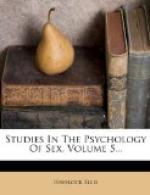The tendency to treasure the relics of a beloved person, more especially the garments, is the simplest and commonest foundation of erotic symbolism. It is without doubt absolutely normal. It is inevitable that those objects which have been in close contact with the beloved person’s body, and are intimately associated with that person in the lover’s mind, should possess a little of the same virtue, the same emotional potency. It is a phenomenon closely analogous to that by which the relics of saints are held to possess a singular virtue. But it becomes somewhat less normal when the garment is regarded as essential even in the presence of the beloved person.[10]
While an extremely large number of objects and acts may be found to possess occasionally the value of erotic symbols, such symbols most frequently fall into certain well-defined groups. A vast number of isolated objects or acts may be exceptionally the focus of erotic contemplation, but the objects and acts which frequently become thus symbolic are comparatively few.
It seems to me that the phenomena of erotic symbolism may be most conveniently grouped in three great classes, on the basis of the objects or acts which arouse them.
I. PARTS OF THE BODY.—A. Normal: Hand, foot, breasts, nates, hair, secretions and excretions, etc.
B. Abnormal: Lameness, squinting, pitting of smallpox, etc. Paidophilia or the love of children, presbyophilia or the love of the aged, and necrophilia or the attraction for corpses, may be included under this head, as well as the excitement caused by various animals.
II. INANIMATE OBJECTS.[11]—A. Garments: Gloves, shoes and stockings and garters, caps, aprons, handkerchiefs, underlinen.
B. Impersonal Objects: Here may be included all the various objects that may accidentally acquire the power of exciting sexual feeling in auto-erotism. Pygmalionism may also be included.
III. ACTS AND ATTITUDES.—A. Active: Whipping, cruelty, exhibitionism. B. Passive: Being whipped, experiencing cruelty. Personal odors and the sound of the voice may be included under this head. C. Mixoscopic: The vision of climbing, swinging, etc. The acts of urination and defecation. The coitus of animals.
Although the three main groups into which the phenomena of erotic symbolism are here divided may seem fairly distinct, they are yet very closely allied, and indeed overlap, so that it is possible, as we shall see, for a single complex symbol to fall into all three groups.




